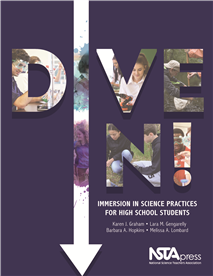Dive In! Immersion in Science Practices for High School Students
By Carole Hayward
Posted on 2017-05-15
 Are you ready to integrate science practices into your classroom?
Are you ready to integrate science practices into your classroom?
How feasible are student-directed science investigations within the curricular expectations at your school? How can you create opportunities for student-directed investigations in the classroom? Have you ever considered partnering with a scientist to add depth to your lessons?
These are some of the central questions of the new book Dive In! Immersion in Science Practices for High School Students by Karen J. Graham, Lara M. Gengarelly, Barbara A. Hopkins, and Melissa A. Lombard.
Dive In! explains the important ways in which science instruction is evolving. “As instruction shifts to what we term science practice integration (SPI), teachers must abandon a rigid, step-by-step, inauthentic approach to science (e.g., formerly the scientific method) and are expected to implement an authentic approach to science, actively engaging their students in the science practices,” the editors state.
For some teachers, making this shift requires a new way of thinking and planning. Dive In! offers strategies to get started. The book is the outcome of a collaborative study that brought together high school teachers and graduate-level scientists from the University of New Hampshire to participate in inquiry-based projects. The study helped participating teachers to gain experience with doing authentic scientific research and developing ideas that would enhance their classroom instruction.
The great thing about this book is that it’s practical and easy to apply to your own teaching. Dive In! looks at the challenges and benefits of making the instructional shift to integrating science practices; offers troubleshooting advice to help you navigate potential problems; and provides field-tested lesson plans.
The vignettes explain teachers’ challenges and successes in implementing the outlined strategies. You can see your own struggles or challenges in other teachers’ stories and also see that there is a solution. Each section includes reflection questions that help you analyze your current teaching practices and create a new way of thinking about classroom instruction.
For example, section three discusses how to scaffold science practices in the secondary classroom and offers strategies that teachers have used such as a biology teacher who taught her students to take responsibility for designing their own procedures, and a chemistry teacher who supported students’ development of statistical analysis early in the school year so that they could make sense of the data they would encounter throughout the year.
You can read the sample chapter “Collaborations to Enhance Secondary School Students’ Engagement with the Science Practices” to discover practical examples of collaboration between the secondary school teachers in the PROBE Project and their graduate student scientist partners. The vignettes are both engaging and insightful and offer plenty to ponder.
Dive In! Immersion in Science Practices for High School Students is available in print or as an e-book.
Disclaimer: The views expressed in this blog post are those of the author(s) and do not necessarily reflect the official position of the National Science Teaching Association (NSTA).

